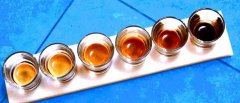Crema Analysis of Italian Coffee Machine Oil how Italian Coffee comes out of Kramer
Crema (grease) I don't understand why we make Crema so much more complicated than itself. Crema is often grossly misdescribed, the most common of which is "an emulsified oil". Well, I think it's fair to say that to a very small extent. As far as we know, the amount of oil obtained by Espresso in the extraction process is unique. In the process of Espresso extraction, the energy of steam is used to emulsify the oil and form many small droplets that can be suspended on the liquid surface without flocculation. We all know that grease destroys milk bubbles, and the percentage of oil in Espresso is extremely low. Crema has nothing to do with oil. The CO2 formed in the baking process is released during extraction, and the change of pressure causes it to escape from the liquid phase and form bubbles. So, who is responsible for the surfactant? Not proteins-the baking process removes almost all useful proteins, which are consumed in various forms of reaction, including the favorite Maillard reaction [6]. The actual surfactant is likely to be a derivative of a reaction protein, protein melanin. Protein melanin is a large class of substances formed during baking, and they participate in the brown color of coffee beans. Melanin, together with two other polysaccharides, forms stable milk bubbles. (sugar affects the volume and stability of milk bubbles, but Crema itself is not a surfactant.) Crema is essentially the milk foam of the bottom coffee, so the color of the crema corresponds directly to the color of the bottom coffee.
There may be some misunderstanding here, because in a single cup, a 15-second coffee and a 30-second coffee look the same-but I guarantee that the colors of the two are absolutely different, if you don't believe it, please take a drop of coffee and drop it on the white paper, so the lighter the Crema, the lighter the coffee, the less dissolved in the coffee. There is an inference that oil is a factor in the rapid disappearance of milk bubbles, and the fat content of arabica is twice as high as that of robusta.
In addition, we also master the process of water loss, a good extraction has a significantly different viscosity than a cup of fast extraction, the latter's crema disappears much faster. Similarly, it depends on the amount of substance in your coffee, so there is a link between the color and stability of crema. Tiger spot is a phenomenon that I do not fully understand, I will continue to study.
At present, it is only speculated that Tiger spot is floating on the crema for particles of roasted coffee, maybe we should take some microscope photos! In addition, I will restate the poorly described parts of the article in the future. Please ask questions in the comments!

Note:
[1] Surface tension: TAT surface tension is the force that promotes the contraction of the liquid surface, in this case, it refers to a kind of contraction force of the bubble film.
[2] Surfactants: in fact, our daily soap and washing powder are all surfactants.
[3-1] with regard to the question of polarity, we can understand it as "birds of a feather flock together."
[3-2] in fact, the so-called non-polar parts of fat and protein are also slightly polar, but they are too "different" for water.
Important Notice :
前街咖啡 FrontStreet Coffee has moved to new addredd:
FrontStreet Coffee Address: 315,Donghua East Road,GuangZhou
Tel:020 38364473
- Prev

Analysis of Italian espresso oil Crema Italian coffee how to produce crema?
An in-depth understanding of the nature of crema will be of great help for baristas to make a good cup of concentrate. Today, the teacher of Chongqing Brista barista barista training course will give you a detailed analysis of crema to help you understand espresso and improve coffee making skills. In the process of looking for a cup of concentration with no bitterness and excellent flavor, you may encounter a bad concentrate every day, and crema is one of them.
- Next

How does Italian coffee come out crema? What is CREMA for espresso?
Roasting coffee beans in the process, coffee beans will produce a lot of carbon dioxide, most of them will be released in the cooling process, a few will continue to be stored in the bean body, grinding coffee powder will release these gases, therefore, after grinding coffee powder needs to make coffee as soon as possible. When hot water hits the coffee powder under high pressure, it will emulsify the insoluble oils in the coffee powder and
Related
- Beginners will see the "Coffee pull flower" guide!
- What is the difference between ice blog purified milk and ordinary milk coffee?
- Why is the Philippines the largest producer of crops in Liberia?
- For coffee extraction, should the fine powder be retained?
- How does extracted espresso fill pressed powder? How much strength does it take to press the powder?
- How to make jasmine cold extract coffee? Is the jasmine + latte good?
- Will this little toy really make the coffee taste better? How does Lily Drip affect coffee extraction?
- Will the action of slapping the filter cup also affect coffee extraction?
- What's the difference between powder-to-water ratio and powder-to-liquid ratio?
- What is the Ethiopian local species? What does it have to do with Heirloom native species?

